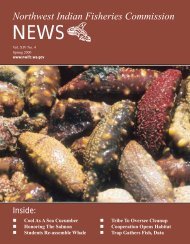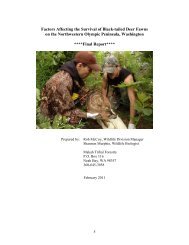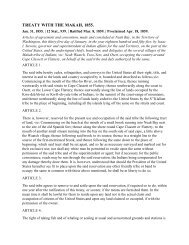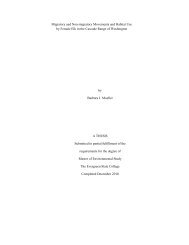NWIFC News - NWIFC Access - Northwest Indian Fisheries ...
NWIFC News - NWIFC Access - Northwest Indian Fisheries ...
NWIFC News - NWIFC Access - Northwest Indian Fisheries ...
You also want an ePaper? Increase the reach of your titles
YUMPU automatically turns print PDFs into web optimized ePapers that Google loves.
Tribes Corral Elk In North Sound, Sequim<br />
Relocating and fencing are<br />
two solutions being used by<br />
tribal and state co-managers to<br />
deal with problem elk in North<br />
Sound and the Strait of Juan de<br />
Fuca regions.<br />
Six elk from the 500-head<br />
North Cascade herd were captured<br />
in Whatcom County and<br />
transported to mountains near<br />
Darrington in January. The<br />
animals were part of a group<br />
of 75 to 80 elk that eat crops<br />
and destroy fences on farms<br />
near Acme.<br />
Historically, the area near<br />
Darrington was home to large<br />
elk herds. By transplanting<br />
North Cascade elk (also<br />
called the Nooksack herd),<br />
the co-managers are augmenting a declining<br />
population.<br />
“We would like to see elk restored to<br />
all of their historical areas,” said Scott<br />
Upper Skagit policy representative Scott Schuyler corrals elk<br />
in a passive trap near Acme. Photo: K. Neumeyer<br />
Schuyler, a policy representative for the<br />
Upper Skagit Tribe.<br />
The six cow elk were lured into a passive<br />
trap baited with apples. Upper Skagit<br />
technicians, along with state Fish and<br />
Wildlife officers and staff from<br />
the Sauk-Suiattle and Tulalip<br />
Tribes, fitted the elk with radio<br />
transmitter collars so they<br />
could track them after release.<br />
Near Sequim, members of<br />
the public opposed moving the<br />
Dungeness Roosevelt elk herd<br />
out of the region. Instead, the<br />
co-managers are planning to<br />
move the herd a short distance<br />
south of Highway 101 and<br />
construct fences to keep the<br />
animals away from traffic and<br />
growing urban areas.<br />
The elk, a local icon in Sequim,<br />
have become accustomed<br />
to residential areas<br />
and nearby agricultural lands.<br />
They cause tens of thousands<br />
of dollars in damage to farmers’ crops<br />
each year.<br />
– K. Neumeyer & T. Royal<br />
Sauk-Suiattle Tribe Leads Bald Eagle Count<br />
From afar, an adult bald eagle is easy to spot because of its<br />
white head – unless the trees are covered in snow.<br />
In January, the Sauk-Suiattle Tribe’s Wildlife Manager Chris<br />
Danilson and Watershed Manager Scott Morris studied dark<br />
Chris Danilson, left, and Scott Morris, Sauk-Suiattle Tribe natural<br />
resource department personnel, count eagles on a snowy day<br />
along the lower Sauk River. Photo: K. Neumeyer<br />
shapes in the trees through binoculars, trying to make out the<br />
tell-tale white heads against a snowy backdrop.<br />
Bald eagles are an indicator species of the overall health of<br />
the area’s rivers. A strong population of eagles suggests that the<br />
rivers have plentiful salmon and the water quality is healthy.<br />
The Nature Conservancy began surveying eagles on the lower<br />
Sauk River in 1996, but changing priorities and limited funds<br />
brought the Sauk survey to an end.<br />
The Sauk-Suiattle Tribe took over the annual count in November<br />
2005. Throughout the winter, staffers visited about 10<br />
sites weekly along the lower 21 miles of the river, noting the<br />
location, activity and age of every visible eagle. The tribe welcomed<br />
members of the community to accompany technicians<br />
on the eagle count.<br />
“It’s wonderful that people are learning about the cultural<br />
significance of our eagles and that they are protected,” said<br />
Sauk-Suiattle Chair Janice Mabee. “We feel very blessed that<br />
they come into our land for the winter.”<br />
The Skagit River basin, which includes the Sauk River, hosts<br />
the largest wintering bald eagle population in the lower 48 states.<br />
From November to January, bald eagles migrate from Alaska<br />
and British Columbia to feast on salmon carcasses in the Skagit<br />
and Sauk rivers. Typically, surveyors throughout the basin count<br />
between 400 and 500 eagles a day during peak season.<br />
– K. Neumeyer<br />
15









